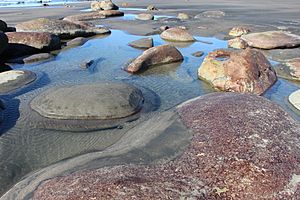Urenui facts for kids
Quick facts for kids
Urenui
|
|
|---|---|
| Country | New Zealand |
| Region | Taranaki Region |
| Territorial authority | New Plymouth District |
| Ward |
|
| Community | Clifton Community |
| Electorates |
|
| Area | |
| • Total | 3.65 km2 (1.41 sq mi) |
| Population
(June 2023)
|
|
| • Total | 430 |
| • Density | 117.8/km2 (305/sq mi) |
Urenui is a settlement in northern Taranaki, in the North Island of New Zealand. It is located on State Highway 3 close to the shore of the North Taranaki Bight, 13 kilometres east of Waitara and 6 km south-west of Mimi. The Urenui River flows past the settlement into the North Taranaki Bight.
Contents
Etymology
The New Zealand Ministry for Culture and Heritage gives a translation of "great courage" for Urenui, noting that courage is "a figurative expression". A fuller explanation is that the name was given by Manaia in honour of his well-endowed son.
History
The town was the site of the Urenui Redoubt, created in winter 1865 during the Second Taranaki War. Originally envisioned as a settlement for Māori loyal to the colonial government, however by 1866 it was decided that the town should be a settlement for soldiers.
Demographics
Urenui is defined by Statistics New Zealand as a rural settlement and covers 3.65 km2 (1.41 sq mi) and had an estimated population of 430 as of June 2023, with a population density of 118 people per km2. It is part of the wider Tikorangi statistical area, which covers 167.79 km2 (64.78 sq mi).
| Historical population | ||
|---|---|---|
| Year | Pop. | ±% p.a. |
| 2006 | 429 | — |
| 2013 | 432 | +0.10% |
| 2018 | 414 | −0.85% |
Urenui had a population of 414 at the 2018 New Zealand census, a decrease of 18 people (−4.2%) since the 2013 census, and a decrease of 15 people (−3.5%) since the 2006 census. There were 186 households, comprising 210 males and 198 females, giving a sex ratio of 1.06 males per female, with 63 people (15.2%) aged under 15 years, 45 (10.9%) aged 15 to 29, 180 (43.5%) aged 30 to 64, and 126 (30.4%) aged 65 or older.
Ethnicities were 89.1% European/Pākehā, 20.3% Māori, 0.0% Pacific peoples, 0.7% Asian, and 1.4% other ethnicities. People may identify with more than one ethnicity.
Although some people chose not to answer the census's question about religious affiliation, 55.8% had no religion, 31.9% were Christian, 0.7% were Buddhist and 0.7% had other religions.
Of those at least 15 years old, 36 (10.3%) people had a bachelor's or higher degree, and 81 (23.1%) people had no formal qualifications. 54 people (15.4%) earned over $70,000 compared to 17.2% nationally. The employment status of those at least 15 was that 153 (43.6%) people were employed full-time, 45 (12.8%) were part-time, and 3 (0.9%) were unemployed.
Marae
Urenui Marae, located about 3 kilometres from the town, is the only remaining marae of Ngāti Mutunga. It includes Te Aroha meeting house.
In October 2020, the Government committed $363,060 from the Provincial Growth Fund to upgrade the marae, creating 21 jobs.
Education
Urenui School is a coeducational contributing primary (years 1–6) school with a roll of 95 students as of February 2024. The school was founded in 1876 and celebrated its 125th jubilee in 2001.
Notable people
- Māui Pōmare, politician
- Te Rangi Hīroa (Sir Peter Buck), doctor, politician


